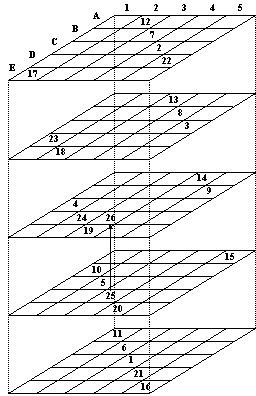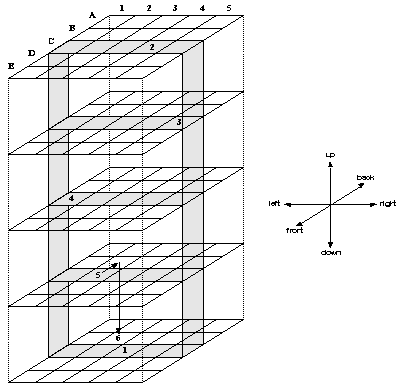Problem B
Magic Cube
Input: standard input
Output: standard output
Time Limit: 1 second
|
An N ´ N ´ N magic cube is a cube composed of N3 consecutive integers (usually 1 through N3) arranged in such way that each row, each column, each main diagonal of the square cross sections, and each of the four triagonals containing N integers adds up to the same sum. Though it is not easy to construct a magic cube when N is even, there is a very simple approach for constructing one when N is odd. |
Fig. 1: Triagonals (dotted lines) |
To construct an odd order magic cube, start by placing the integer 1 at the center of the bottom layer of the cube (Fig. 2). Then proceed diagonally down to the right along the central vertical square cross section (the shaded vertical plane in Fig. 2), and keep placing consecutive integers in every empty location you visit. When you run off the bottom of the plane, your reenter at the top. When you run off the right-hand side, you reenter on the left-hand side.
|
Every time you find a non-empty location on your way, just go back one layer and down one, as shown in Fig. 2 for the move from 5 to 6. Continue to proceed diagonally in the new plane, repeating the “one back and one down” step as required. If the “one back and one down” step does not work, i.e., you still arrive at a non-empty location, just go up one layer and continue moving diagonally. The “up one” step is shown in Fig. 3 for the move from 25 to 26. |
Fig. 2: The “one back and one down” move |

Fig. 3: The “up one” move
Input
The input may
contain multiple test cases. Each line of the input contains an odd integer N
(1 £
N
£
25) giving the dimension of the cube.
Input is terminated by a zero. This zero should not be processed.
Output
For each test case in the input output the corresponding magic cube as follows. First print the numbers in the top layer of the cube, followed by numbers in the second layer, then the numbers in the third layer, and so on. For each layer first print the numbers in row A (see Fig. 2 and Fig. 3) on one line from left to right (A1 to AN), followed by the numbers in row B on the next line, then row C on the third line, and so on. Print each number right aligned on a field of width 5, and separate two successive such fields on the same line by a white space character. Print a blank line between two successive layers.
Separate the output for every two successive test cases by a blank line.
Sample
Input Output
for Sample Input
|
3 5 0 |
21 5
16 13
27 2 8
10 24 17
19 6 3 14 25 22
9 11 4
18 20 26
1 15 12
23 7 110
12 44 71
78 98
105 7 39
66 61
93 125 2
34 29
56 88 120
22 17
49 51 83
115 79
106 13 45
72 67
99 101 8
40 35
62 94 121
3 23
30 57 89
116 111
18 50 52
84 73
80 107 14
41 36
68 100 102
9 4
31 63 95
122 117
24 26 58
90 85
112 19 46
53 42
74 76 108
15 10
37 69 96
103 123
5 32 64
91 86
118 25 27
59 54
81 113 20
47 11
43 75 77
109 104
6 38 70
97 92
124 1
33 65 60
87 119 21
28 48
55 82 114
16 |
Problem setter: Rezaul
Alam Chowdhury, University of Texas at Austin

